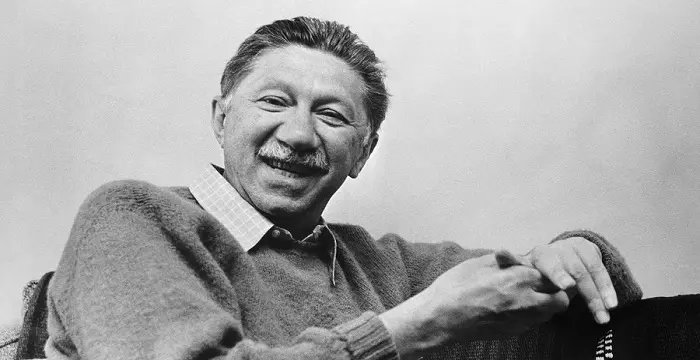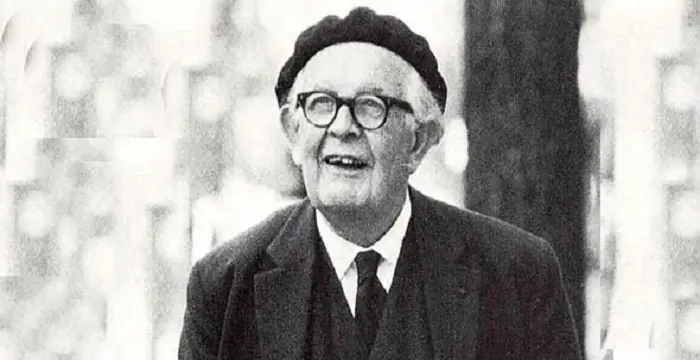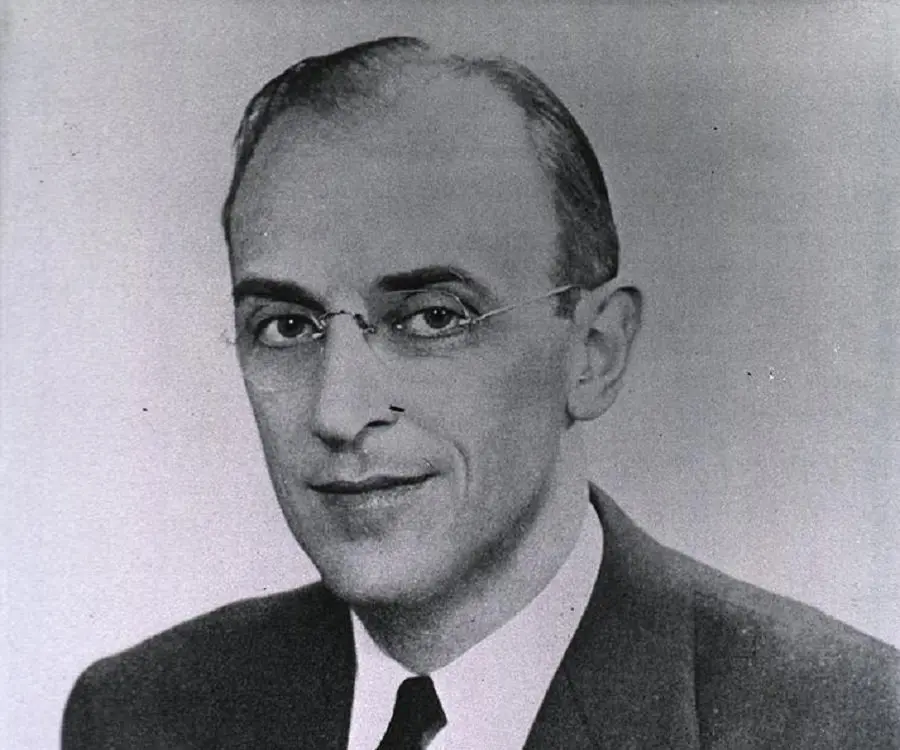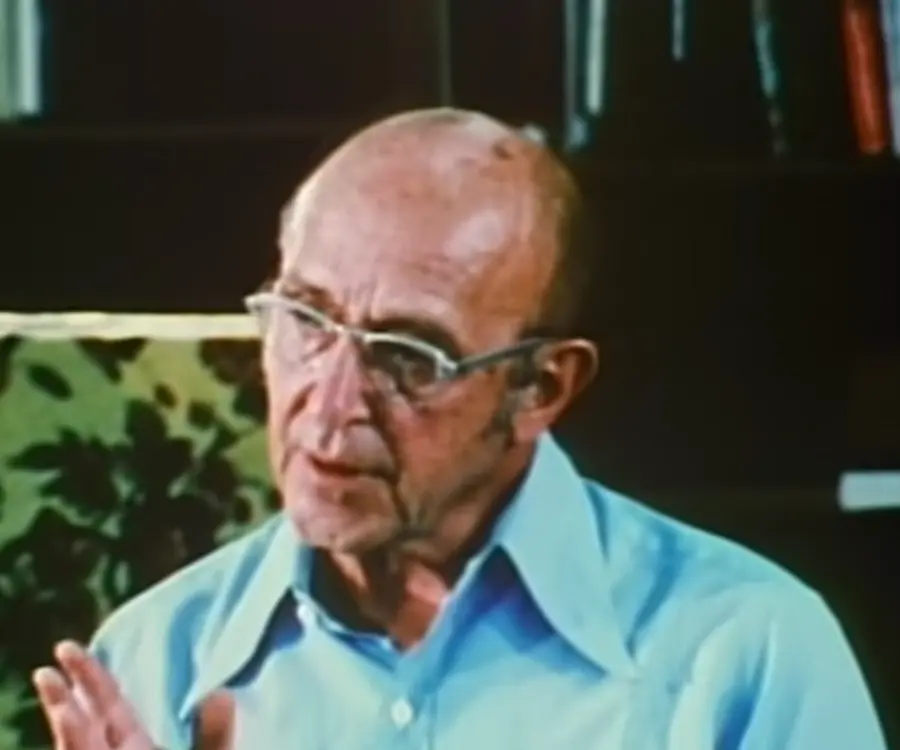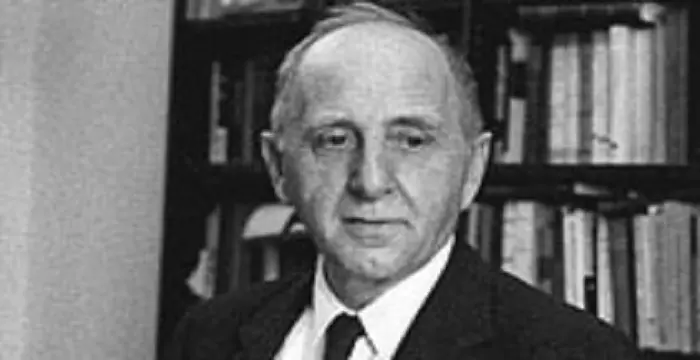
Carl Rogers - Psychologists, Birthday and Family
Carl Rogers's Personal Details
Carl Rogers was an important American psychologist and educator who along with Abraham Moslow founded the Humanistic Approach’ to psychology
| Information | Detail |
|---|---|
| Birthday | January 8, 1902 |
| Died on | February 4, 1987 |
| Nationality | American |
| Famous | Columbia University, Intellectuals & Academics, Psychologists |
| Known as | Carl R. Rogers |
| Universities |
|
| Notable Alumnis |
|
| Birth Place | Oak Park |
| Gender | Male |
| Sun Sign | Capricorn |
| Born in | Oak Park |
| Famous as | Psychologist |
| Died at Age | 85 |
// Famous Psychologists
Abraham Maslow
Abraham Maslow was a humanistic psychologist best known for his theory of self-actualization. This biography of Abraham Maslow provides detailed information about his childhood, life, achievements, works & timeline.
Felicitas Rombold
Felicitas Rombold is a German model, academic and the wife of actor Daniel Brühl. Check out this biography to know about her birthday, childhood, family life, achievements and fun facts about her.
Jean Piaget
Jean Piaget was a psychologist and philosopher known for his theory of cognitive development. This biography of Jean Piaget provides detailed information about his childhood, life, achievements, works & timeline.
Carl Rogers's photo
Who is Carl Rogers?
Carl Rogers was an important American psychologist and educator who along with Abraham Moslow founded the Humanistic Approach’ to psychology. As a teenager, living on a farm nurtured an interest in agriculture which later led to an interest in science, but he also developed a special compassion and understanding for people. He was a very good listener, but it took him some time to find his own path. He changed his major three times before settling on clinical psychology. He rejected the dominant approaches to Psychotherapy and Psychology of the time based on his experience with troubled children, and started developing his own approach. He worked as psychotherapist while teaching, which gave him unique opportunities to explore his ideas. His Person-Centered approach would end up turning the fields of Psychotherapy and Psychology upside down. The approach transferred equally well to education, industry, and conflict resolution. Believing the therapist and client to be equals, his approach changed forever the therapist-client relationship. He believed strongly that, with help, people are capable of understanding their own problems and figuring out how to solve them for themselves. He was relentless in researching, testing, and understanding his approach and the human mind. Today, the Person-Centered Approach is the most widely used therapy approach in the United States
// Famous Intellectuals & Academics
Bertil Gotthard Ohlin
Bertil Gotthard Ohlin was a famous Swedish economist. This biography profiles his childhood, family life & achievements.
Emily Greene Balch
Emily Greene Balch was an American economist, sociologist and pacifist who won the 1946 Nobel Peace Prize. This biography of Emily Greene Balch provides detailed information about her childhood, life, achievements, works & timeline.
Martin Buber
One of the greatest philosophers to have ever walked on earth, Martin Buber contributions to philosophy is a long-standing one. Explore all about his profile, childhood, life and timeline here.
Childhood & Early Life
Carl Rogers was born on January 8, 1902, in Oak Park, Illinois. His father was a civil engineer and his mother, a stay-at-home mom. Although he received a stern Protestant upbringing, he acquired a more compassionate vision of Christianity.
Before kindergarten, he learned to read, and he also had an early fascination with agriculture which led to his later interest in science.
In 1922, while attending the University of Wisconsin, he joined a Christian mission to China. During his 6-month stay, he developed a more compassionate and less harsh understanding of Christianity.
In 1924, inspired by his experience on a Christian mission to China, he enrolled in the Union Theological Seminary in New York City.
Career
In 1926, Carl Rogers became disenchanted with the fixed mindset of the seminary and decided to pursue an education in clinical psychology at the Columbia University's Teacher’s College in New York City.
In 1928, he became a child psychologist at the Rochester Society for the Prevention of Cruelty to Children. During his work in the Child Study Department, his theories about personality began to develop.
In 1931, he finished his doctorate in clinical psychotherapy which involved the development of a psychological test that would help identify ways to make low income children’s lives better.
In 1939, based on his work with disadvantaged and often distressed children at the Rochester Society for the Prevention of Cruelty to Children, he published his first book, ‘The Clinical Treatment of the Problem Child’.
In 1940, he became a professor of Psychology at Ohio State University. This enabled him to clinically research his new ‘non-directive approach’.
In 1942, he released ‘Counseling and Psychotherapy’ where he described his ‘non-directive approach’ including full transcripts of his therapy sessions with his client, Herbert Bryan.
In 1945, the University of Chicago asked him to join their faculty as a professor of Psychology and to establish a new counseling center.
In 1946, he became president of the newly reformed American Psychological Association (APA) which united academic and applied psychologists.
In 1951, based on his experiences and research at the University of Chicago's Counseling Center, he established a clear vision for his approach and published ‘Client-Centered Therapy’.
In 1957, he joined both the departments of psychology and psychiatry at the University of Wisconsin. He continued to study and test his theory throughout his tenure at the University; at one point, he conducted a large scale study using client-centered therapy with schizophrenics from Mendota State Hospital.
In 1961, he published ‘On Becoming a Person’, a collection of writings and lectures from the past 10 years. In this book, he described how he developed his person-centered approach to therapy.
From 1964 to 1974, he lectured around the United States, researched and wrote more books and papers while continuing to offer his services as a therapist.
From 1975 –1985, he ran Person-Centered Approach workshops in the United States, Europe, South America, Japan, and Russia.
Major Works
Carl Rogers along with Abraham Maslow established the Humanistic Approach to psychology. They discarded the leading approaches of their time, namely, behaviorism and psychoanalysis. They found them too limited in understanding the human experience and the whole person. They put forward instead the principle of self-actualization, a basic human need to achieve one’s potential in life.
Carl Rogers revolutionized the relationship between the therapist and the client with his Person-Centered (also known Client-Centered) Approach. He emphasized listening, understanding, and helping the client to find their own solution rather than prescribing the solution for the client. This approach found further application in education, industry, and conflict resolution.
Awards & Achievements
In 1956, he was recognized by the American Psychological Association for his ground-breaking psychotherapy research and was honored with the ‘Award for Distinguished Scientific Contributions’.
In 1972, he was presented with the American Psychological Association’s ‘Award for Distinguished Professional Contributions to Psychology’ for his development of the Person-Centered Approach to psychotherapy and counseling.
Personal Life & Legacy
On August 28, 1924, in spite of his parents’ objections, he married Helen Elliot. In 1926, their first child, David was born; he was followed in 1928 by Natalie who is now is a prominent expressive arts therapist.
On February 4, 1987, Carl Rogers died of a heart attack in San Diego, California. Days prior to his death, he had undergone hip surgery and been nominated for the Nobel Peace Prize for his work in conflict resolution in South Africa and Northern Ireland.
His Person-Centered approach to psychotherapy is the dominant approach to therapy in the United States today. It is applied in psychotherapy, education, and business settings with great success.
Trivia
Carl Rogers developed a ‘non-directive’ counseling program for returning World War II veterans.
His book, ‘Freedom to Learn’ (1969) has inspired educators in the United States and abroad to adopt a more student-centered learning approach
// Famous Columbia University
Helen Morris
Helen Morris is a former book editor, TV producer and the wife of Academy Award winning director Martin Scorsese. Check out this biography to know about her birthday, childhood, family life, achievements and fun facts about her.
Simon Kuznets
Simon Kuznets was a noted Russian-American economist, statistician, demographer, and economic historian. Check out this biography to know about his childhood, family life, achievements and other facts related to his life.
Anna Paquin
Anna Paquin is a Kiwi film, theatre and television actress known for her roles in movies like ‘The Piano’, ‘Fly Away Home’, and ‘X-Men. This biography provides detailed information about her childhood, life, achievements, works & timeline.
Carl Rogers's awards
| Year | Name | Award |
|---|---|---|
Other | ||
| 0 | Professional Contribution Award and The Distinguished Scientific Contribution Award | |
Carl Rogers biography timelines
- // 8th Jan 1902Carl Rogers was born on January 8, 1902, in Oak Park, Illinois. His father was a civil engineer and his mother, a stay-at-home mom. Although he received a stern Protestant upbringing, he acquired a more compassionate vision of Christianity.
- // 1922In 1922, while attending the University of Wisconsin, he joined a Christian mission to China. During his 6-month stay, he developed a more compassionate and less harsh understanding of Christianity.
- // 1924In 1924, inspired by his experience on a Christian mission to China, he enrolled in the Union Theological Seminary in New York City.
- // 1924 To 1928On August 28, 1924, in spite of his parents’ objections, he married Helen Elliot. In 1926, their first child, David was born; he was followed in 1928 by Natalie who is now is a prominent expressive arts therapist.
- // 1926In 1926, Carl Rogers became disenchanted with the fixed mindset of the seminary and decided to pursue an education in clinical psychology at the Columbia University's Teacher’s College in New York City.
- // 1928In 1928, he became a child psychologist at the Rochester Society for the Prevention of Cruelty to Children. During his work in the Child Study Department, his theories about personality began to develop.
- // 1931In 1931, he finished his doctorate in clinical psychotherapy which involved the development of a psychological test that would help identify ways to make low income children’s lives better.
- // 1939In 1939, based on his work with disadvantaged and often distressed children at the Rochester Society for the Prevention of Cruelty to Children, he published his first book, ‘The Clinical Treatment of the Problem Child’.
- // 1940In 1940, he became a professor of Psychology at Ohio State University. This enabled him to clinically research his new ‘non-directive approach’.
- // 1942In 1942, he released ‘Counseling and Psychotherapy’ where he described his ‘non-directive approach’ including full transcripts of his therapy sessions with his client, Herbert Bryan.
- // 1945In 1945, the University of Chicago asked him to join their faculty as a professor of Psychology and to establish a new counseling center.
- // 1946In 1946, he became president of the newly reformed American Psychological Association (APA) which united academic and applied psychologists.
- // 1951In 1951, based on his experiences and research at the University of Chicago's Counseling Center, he established a clear vision for his approach and published ‘Client-Centered Therapy’.
- // 1956In 1956, he was recognized by the American Psychological Association for his ground-breaking psychotherapy research and was honored with the ‘Award for Distinguished Scientific Contributions’.
- // 1957In 1957, he joined both the departments of psychology and psychiatry at the University of Wisconsin. He continued to study and test his theory throughout his tenure at the University; at one point, he conducted a large scale study using client-centered therapy with schizophrenics from Mendota State Hospital.
- // 1961In 1961, he published ‘On Becoming a Person’, a collection of writings and lectures from the past 10 years. In this book, he described how he developed his person-centered approach to therapy.
- // 1964 To 1974From 1964 to 1974, he lectured around the United States, researched and wrote more books and papers while continuing to offer his services as a therapist.
- // 1969His book, ‘Freedom to Learn’ (1969) has inspired educators in the United States and abroad to adopt a more student-centered learning approach
- // 1972In 1972, he was presented with the American Psychological Association’s ‘Award for Distinguished Professional Contributions to Psychology’ for his development of the Person-Centered Approach to psychotherapy and counseling.
- // 1975 To 1985From 1975 –1985, he ran Person-Centered Approach workshops in the United States, Europe, South America, Japan, and Russia.
- // 4th Feb 1987On February 4, 1987, Carl Rogers died of a heart attack in San Diego, California. Days prior to his death, he had undergone hip surgery and been nominated for the Nobel Peace Prize for his work in conflict resolution in South Africa and Northern Ireland.
// Famous Capricorn Celebrities peoples
Weston Koury
All about American social media star Weston Koury, including his age, family life, girlfriends, birthday, and some fun facts.
Elin Nordegren
Elin Nordegren is the ex-wife of Tiger Woods. Check out this biography to know about her childhood, family life, achievements and fun facts about her life.
ItsJustNick
ItsJustNick is a Canadian YouTube star & social media personality. Let’s take a look at his family and personal life including age, date of birth, net worth, girlfriends, and fun facts.
Rudan Custodio
Check out all that you wanted to know about Rudan Custodio, the famous American YouTube Personality; his birthday, his family and personal life, his girlfriends, fun trivia facts and more.
Zahara Jolie-Pitt
Zahara Jolie-Pitt is the adopted daughter of former celebrity couple Angelina Jolie and Brad Pitt. Check out this biography to know about her childhood, family life and fun facts about her.
Adam Dahlberg
Check out all that you wanted to know about Adam Dahlberg, the famous YouTuber and gamer; his birthday, his family and personal life, his wife, fun trivia facts and more.
Carl Rogers's FAQ
What is Carl Rogers birthday?
Carl Rogers was born at 1902-01-08
When was Carl Rogers died?
Carl Rogers was died at 1987-02-04
Where was Carl Rogers died?
Carl Rogers was died in San Diego
Which age was Carl Rogers died?
Carl Rogers was died at age 85
Where is Carl Rogers's birth place?
Carl Rogers was born in Oak Park
What is Carl Rogers nationalities?
Carl Rogers's nationalities is American
What was Carl Rogers universities?
Carl Rogers studied at Columbia University, University of Wisconsin-Madison, Teachers College, Columbia University, Columbia University, Union Theological Seminary
What was Carl Rogers notable alumnis?
Carl Rogers's notable alumnis is Columbia University
What is Carl Rogers's sun sign?
Carl Rogers is Capricorn
How famous is Carl Rogers?
Carl Rogers is famouse as Psychologist
